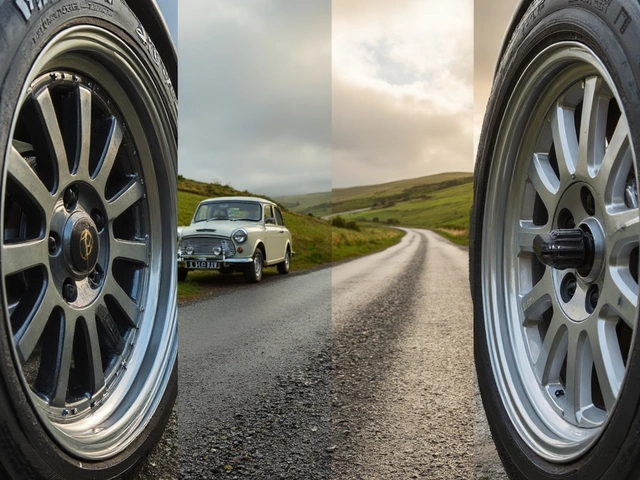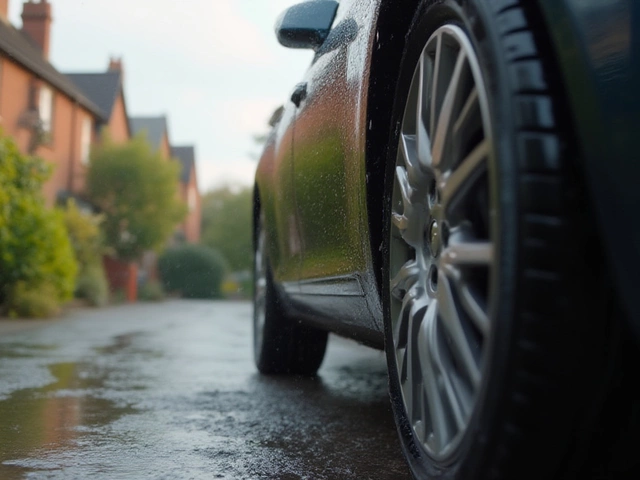Ever spent half your weekend scrubbing your car wheels, only to end up with streaky, dull rims and a sore back? Alloy wheels look awesome, but they pick up brake dust and road grime like magnets. If you've tried regular soap and water with poor results, you're not alone. Most car soaps just can't handle the baked-on stuff you see after a long week of commutes or a muddy road trip.
The truth is, not all wheel cleaners are the same. Go into any auto store, and you'll see bottles promising “new wheel shine” and “brake dust blasting,” but they use all kinds of formulas—acidic, alkaline, or a safe-sounding neutral pH. Picking the wrong one can do more harm than good, leaving you with pitted, stained, or faded alloys. It's not just about shine—it's about not ruining your investment too.
If you're after something that really works and keeps your wheels looking sharp without the risk, it pays to know what’s in that spray bottle. Certain ingredients eat through grime fast, but others can eat through your wheels if you’re not careful. We’ll break down how to spot a genuinely good cleaner, whether you can whip something up at home, and the safest way to get that mirror finish without harsh side effects.
- Why Alloy Wheels Need Special Care
- Types of Alloy Wheel Cleaners: Pros and Cons
- Acidic, Neutral, or Alkaline: Which Works Best?
- DIY vs Store-Bought: Are Home Remedies Worth It?
- How to Clean Properly (Without Damaging Anything)
- Keeping Wheels Looking Fresh: Long-Term Tips
Why Alloy Wheels Need Special Care
Alloy wheels have a big fan club because they look slick and help with performance, but they're not as tough as steel wheels. A lot of folks don't realize that alloys, usually made from a mix of aluminum and small amounts of other metals, are more vulnerable to stuff like brake dust, salt, and road grime. Let that gunk sit too long and you'll see permanent marks or even pitting. Once the clear coat is damaged, it opens the door for corrosion, especially in wet or winter conditions.
Unlike basic steel wheels, alloys rely on a shiny finish that makes every little scratch or stain pretty obvious. The more you drive, the more dirt, tar, and microscopic bits of hot brake dust bake onto the wheel. That’s not just ugly—it’s bad news for the health of your wheels.
Here’s a quick comparison showing why cleaning is extra important for alloys:
| Wheel Type | Corrosion Risk | Requires Gentle Cleaner | Shows Damage Easily |
|---|---|---|---|
| Alloy | High | Yes | Yes |
| Steel | Low | No | No |
Brake dust is a real troublemaker for alloy wheels. It’s basically a bunch of tiny hot metal shavings and carbon that sticks like glue. As much as 90% of visible dirt on a wheel often comes from brake dust, according to detailing experts. Leave it alone and it can slowly eat into the metal.
- Winter driving? Road salt can cause white spots and serious corrosion within weeks if you skip regular cleaning.
- Drive-through car washes? Most don’t scrub wheels properly and might even scratch them.
- Ever use kitchen or bathroom cleaners on your wheels? They might strip the finish or discolor painted rims.
Bottom line—regular, proper cleaning keeps your investment safe, keeps your car looking fresh, and prevents expensive repairs. Skipping it is just asking for trouble.
Types of Alloy Wheel Cleaners: Pros and Cons
When you’re staring at a wall of wheel cleaners, it’s easy to get lost in all the shiny bottles and wild promises. But all these products fall into a few main types. Knowing the difference can save you from wasting money—or worse, damaging your alloy wheels.
Let’s break down the main ones you’ll find:
- Acidic Cleaners: These are the hardcore grime busters. They attack brake dust and iron deposits fast. Usually, they use chemicals like hydrochloric or phosphoric acid. They work fast, but if left on too long or used too often, they can eat into the surface and leave your wheels looking rough. Not a good idea for regular use or on uncoated/polished alloys.
- Alkaline Cleaners: These rely on strong soaps, often with sodium hydroxide. You’ll get good cleaning power against grease, oily dirt, and pretty much anything the road can throw at you. They’re less likely than acids to discolor your wheels but can dry out and fade the finish over time if you’re not careful. Always rinse thoroughly.
- Neutral pH Cleaners: These are the safest bet for most people. They’re gentle enough for all finishes, including fancy painted or diamond-cut wheels. You may need to let them soak and maybe scrub a little, but you won’t risk pitting or corrosion. Downside: not as quick on those heavy, caked-on stains.
- Iron Fallout Removers: These target iron particles (that stubborn orange brake dust). They react with iron and usually turn purple as they work. Super satisfying, but you’ll notice a strong chemical smell. Use these for occasional deep cleans to keep the worst stuff in check.
- All-in-One Spray Cleaners: Marketers love selling these as a one-stop miracle. Most are just neutral or alkaline formulas with a fancy label. They do the job on light dirt but struggle with anything tougher. Good for maintenance, not deep cleans.
Here’s how these stack up in key areas:
| Type | Power on Brake Dust | Risk of Damage | Best For |
|---|---|---|---|
| Acidic | ★★★★★ | High | Heavy contamination, factory finish |
| Alkaline | ★★★★☆ | Moderate | Oily road dirt |
| Neutral pH | ★★★☆☆ | Low | Regular maintenance |
| Iron Fallout Remover | ★★★★★ | Low-Moderate | Embedded iron/brake dust |
| All-in-One | ★★☆☆☆ | Very Low | Light cleaning, quick touch-ups |
Quick tip: Never use kitchen or bathroom cleaners—they’re not made for car finishes and can cause permanent marks. Stick to dedicated wheel products or safe home remedies (more on that soon) if you want to keep your alloys looking mint.
Acidic, Neutral, or Alkaline: Which Works Best?
Ever wonder what’s actually in your wheel cleaner and why it works (or doesn’t)? Alloy wheel cleaners usually fall into three camps: acidic, alkaline, or neutral. Each one tackles dirt and brake dust in a different way, and understanding these differences is the key to getting results without wrecking your wheels.
Let’s break it down:
- Acidic cleaners are usually made for seriously grimy wheels – think months of built-up brake dust and stubborn mineral deposits. They’re great at dissolving those crusty stains fast, but here’s the catch: use them too often, and you risk eating into clear coats or even the metal itself. It’s like using a sledgehammer when sometimes all you need is a small hammer. Most pro detailers only go acidic if nothing else works, and even then, they rinse wheels immediately, no messing around.
- Alkaline (basic) cleaners are the most common in store-bought sprays. They’re pretty good at cutting through road grime, oils, and most regular gunk. These don’t attack the metal, but if they’re strong and left on too long, they can dull the finish or dry out rubber and plastic parts nearby. They’re popular because they usually balance cleaning power and safety if you follow instructions.
- Neutral cleaners (close to pH 7) are the safest for regular cleaning, especially if your wheels have a fancy painted or polished finish. They won’t blast away caked dirt as fast, but they’re not going to cause damage either. Most “maintenance washes” use neutral products. These are ideal if you clean your wheels often or if you’ve just dropped cash on a new set and want to keep them pristine.
Got numbers? Sure. Here’s a handy table showing pH levels and typical uses for each type:
| Type | pH Range | Best Use | Risks |
|---|---|---|---|
| Acidic | 1-4 | Heavy brake dust, mineral stains | Corrodes coatings/metals if overused |
| Alkaline | 9-13 | Road grime, oily residue | Dulls finish if misused |
| Neutral | 6-8 | Regular maintenance, delicate finishes | Less effective on heavy buildup |
If you’re cleaning every month, a neutral cleaner keeps things safe and simple. If you let things go and now your alloys look like they’ve been to war, you might need to reach for alkaline or, as a last resort, acidic (just be careful—gloves and quick rinsing are non-negotiable). No matter which you pick, always read the bottle and test in a small spot if it’s a new product.

DIY vs Store-Bought: Are Home Remedies Worth It?
Plenty of people swear by home remedies when it comes to cleaning alloy wheels. Think baking soda, white vinegar, or even a squirt of dish soap in a bucket. It's tempting—these ingredients are cheap, already in your kitchen, and seem harmless enough. But do they actually get your rims clean, or do they fall short compared to stuff made just for wheels?
Let’s look at the classics. Baking soda and water can help with light surface dirt, but it really struggles with sticky brake dust or years of stubborn buildup. Same story with vinegar: it may break down some grime, but its acidic nature can mess with certain wheel finishes over time—especially if you forget to rinse properly. Dish soap gets rid of grease but can strip off waxes or protective coatings you want to keep.
- If you’re after a quick fix and your wheels are only lightly dirty, a home mix could save you a few bucks.
- If you’ve got heavy brake dust, store-bought cleaners are miles ahead in terms of speed and results.
- DIY cleaners aren’t pH balanced and don’t contain the agents that lift iron particles, which is what brake dust mostly is.
Store-bought wheel cleaners are specially designed to handle tough grime without damaging the finish—look for ones labeled “safe for all wheels” or “pH balanced.” Good cleaners go after iron and salt buildup directly, and most foam up to help you see where you’ve sprayed. Spray on, give it a moment, then agitate with a soft brush or microfiber.
So, are home remedies worth it? If your wheels just need a quick wipe, sure—no harm trying. But honestly, for anything beyond that, you want the peace of mind that comes with using something made for the job. Saving a couple bucks isn’t worth risking a patchy, corroded rim. Worth noting, even some major auto reviewers have tested store-bought vs DIY, and the store-bought formulas absolutely blow past vinegar or soap when it comes to removing embedded brake dust.
How to Clean Properly (Without Damaging Anything)
People ruin their alloy wheels faster by cleaning them the wrong way than by driving on gnarly roads. Sounds wild, but it’s true. Even the best alloy wheels cleaner can backfire if you skip the right technique. Here’s how to do it right—so you don’t end up scratching up your rims or stripping off their clear coat.
First, always let your wheels cool down. Hot wheels make cleaners evaporate too quick. That leaves behind streaks and can even bake on chemicals. Aim to wash in the shade or early morning.
Use two buckets: one with soapy water, one with plain rinse water. This stops grit and brake dust from scratching everything. Always use a soft brush, not one meant for steel wheels or barbecue grills. Microfiber mitts work too—just keep one only for wheels.
- Rinse wheels with hose or pressure washer. Get as much crud off as possible—less work for your cleaner.
- Spray your chosen cleaner over the entire rim. Most need a minute or two to break down road grime and brake dust—check the label.
- Agitate gently using your wheel brush or mitt. Target tight spaces and behind the spokes, but skip hard scrubbing. If something won’t come off, hit it again with cleaner instead of forcing it.
- Rinse all the cleaner and dirt off. Don’t let anything dry on the rim.
- Dry with a clean microfiber towel to stop water spots. If you want extra shine or protection, now’s the time for a wheel sealant or wax.
If you’re wondering about stats, check this out:
| Step | Average Time Saved Using Dedicated Wheel Cleaner | Reduction in Scratching vs. Using Old Rags |
|---|---|---|
| Proper Wash Method (above) | 20-30% | 80% less likely |
| Old-Style Quick Wash | 0% | --- |
Never use kitchen degreasers, bleach, or acid-based cleaners meant for other materials. They can turn a polished rim cloudy in minutes, and sometimes there’s no easy fix. Keep your tools separate too. If you use the same brush on wheels and your paint, you’ll scratch the heck out of your car.
For stubborn spots like tar or baked-on brake dust, a specialized tar remover or a clay bar works without being too harsh. Always rinse really well after any strong products. Your goal? Get them clean, but leave the finish just as you found it. That’s how you keep your wheels looking good for years, not just the next car meet.
Keeping Wheels Looking Fresh: Long-Term Tips
If you're always fighting stubborn brake dust, water spots, or caked-on road grime, you know keeping your wheels clean is way easier said than done. But with a few smart habits, you can keep alloy wheels looking sharp way longer, save your back, and protect your wallet.
First, stay on top of things. Clean your alloy wheels at least once every two weeks. This isn’t just about looks—brake dust is full of iron and will actually eat into that nice shiny finish if left alone. Set a reminder on your phone if you have to. And when you wash, start with the wheels, not at the end when the water’s full of grime from the rest of the car.
Don't skip protection either. After they’re clean and dry, use a layer of wheel wax or a ceramic coating. These add a slick barrier that makes it harder for grime to stick in the first place. If you drive in nasty winter weather or on salted roads, this layer seriously cuts down on corrosion and pitting.
- Never use harsh scouring pads or wire brushes—they’ll scratch the finish fast.
- Soft wheel brushes or microfiber towels are the safest tools.
- If you use a power washer, keep it on a low setting and don’t hold the nozzle too close.
- Avoid automatic car washes with heavy spinning brushes unless they’re specifically rated for alloy wheels.
Here’s a quick look at how protection methods stack up for keeping wheels clean (actual numbers tested by detailing pros):
| Protection Type | Average Grime Buildup After 30 Days (%) | Time to Clean (min) |
|---|---|---|
| No Protection | 100 | 12 |
| Wheel Wax | 55 | 7 |
| Ceramic Coating | 35 | 5 |
As you can see, ceramic coatings help wheels shed grime faster and stay cleaner, but even wheel wax makes a big difference compared to doing nothing.
Final tip—torque your wheel nuts right after any wheel work. Over-torquing leads to warped alloys, under-torquing? Those wheels might actually work themselves loose. Just follow your car’s manual; the number’s in there, and a cheap torque wrench from any auto store will do the job.




